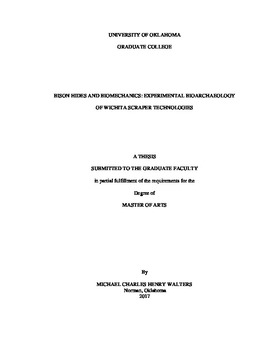| dc.description.abstract | This study utilizes methodologies and theories from biological anthropology, archaeology, and kinesiology to conduct an experiment to test the effects of a change in Wichita scraping technologies during the Pre- and Post-Contact Periods on the musculo-skeletal system. During the Colonial Period, French Traders were increasing their requests of bison hides from trading with Plains Native American Tribes and the Wichita Nation facilitated this demand by changing how their scrapers were produced. Scrapers before trade with the French were smaller and uniformly made, after the French engaged the Wichita for bison hides, scrapers increased in size and were less uniform. To understand how the change in scraper technology affected the bodies of the Wichita women preparing hides, ten female participants scraped bison hides with the two types of scrapers, Pre- and Post-Contact scrapers, and in two positions, kneeling and crouching. Participants had electromyography (EMG) electrodes placed on muscle groups on their arm while scraping to measure the force output of the muscles. Based on the EMG signal, pathologies (i.e., osteoarthritis and enthesopathies) Wichita women might have experienced during this time were postulated. The results of this project indicate that more muscle force is required to scrape using the Post-Contact scraper compared to the Pre-Contact scraper. Because of the greater force, Post-Contact Wichita women are hypothesized to experience an increase in osteoarthritis, larger enthesopathies, and perhaps an earlier age of onset for these diseases. Furthermore, utilizing EMG in activity reconstruction can help to validate previous analyses of activity reconstruction from skeletal populations. Additionally, if a skeletal population is unavailable for analyses, conducting an experiment and recreating the activity in question (i.e. scraping), can allow skeletal biologists to understand how past behaviors affected the musculo-skeletal system. | en_US |
